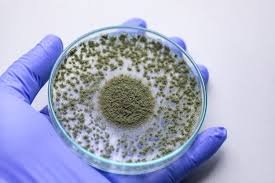Fungus in Pharmaceutical Cleanrooms: Types, Origins, and Decontamination

Fungus in Pharmaceutical Cleanrooms: Types, Origins, and Decontamination
1. Introduction
Cleanrooms in pharmaceutical facilities are designed to maintain controlled levels of particles, microorganisms, and environmental parameters to ensure product sterility and safety.
Despite strict controls, fungal contamination can occur, posing a serious risk to sterile manufacturing due to spores’ resistance and ability to survive harsh conditions.
2. Common Types of Fungi Found in Cleanrooms
-
Molds (Filamentous fungi):
-
Aspergillus spp. (e.g., A. niger, A. fumigatus)
-
Penicillium spp.
-
Cladosporium spp.
-
Alternaria spp.
-
Mucor spp.
-
-
Yeasts (Unicellular fungi):
-
Candida spp. (e.g., C. albicans)
-
Rhodotorula spp.
-
Note: Molds are more common than yeasts in cleanrooms, as spores are easily airborne.
3. Origins of Fungal Contamination
-
Personnel: Improper gowning, shedding of skin cells, hair, or contaminated clothing.
-
HVAC system: Leaks, unclean ducts, faulty HEPA filters, or condensation in air handling units.
-
Water systems: Leaks, stagnant water, or improperly sanitized WFI/PW distribution.
-
Materials & Equipment: Wooden pallets, cardboard boxes, improperly cleaned surfaces, or porous packaging.
-
Construction or Maintenance Work: Dust, building materials, and air infiltration from uncontrolled areas.
-
Cleaning Tools & Agents: Reuse of contaminated mops, cloths, or ineffective disinfectants.
4. Decontamination & Control Strategies
a. Preventive Measures
-
Strict gowning and personnel training.
-
Routine HEPA filter integrity testing and HVAC maintenance.
-
Control of humidity (<60%) to prevent fungal proliferation.
-
Use of fungicidal disinfectants in cleaning rotation.
-
Proper material transfer using pass boxes and sanitization.
b. Decontamination Methods
-
Cleaning & Disinfection:
-
Rotational use of broad-spectrum disinfectants (e.g., quaternary ammonium compounds, hydrogen peroxide, peracetic acid, alcohol).
-
Include fungicidal agents effective against spores (e.g., sporicidal H₂O₂ blends).
-
-
Fumigation / Fogging:
-
With hydrogen peroxide vapor (HPV) or formaldehyde (restricted in many regions).
-
-
HEPA Filter Replacement & Duct Cleaning:
-
If fungal contamination is traced to HVAC system.
-
-
UV Light Exposure:
-
For pass boxes or controlled chambers, effective for surface decontamination.
-
-
Root Cause Elimination:
-
Address water leakage, unsealed penetrations, or damp areas.
-
c. Monitoring & Trending
-
Environmental Monitoring (settle plates, contact plates, active air sampling, swabs).
-
Microbial identification (fungi speciation) to detect recurrent species.
-
Trend analysis to spot seasonal or recurring contamination.
5. Regulatory Expectations
-
EU GMP Annex 1, US FDA, and WHO guidelines emphasize that cleanrooms must be free of mold and fungal spores, as they are unacceptable in sterile product areas.
-
Any fungal detection in Grade A/B areas is treated as a critical contamination requiring immediate investigation, deviation, and CAPA.
✅ In short:
Fungal contamination in cleanrooms is mainly caused by personnel, HVAC failures, water leaks, and poor material handling. Common fungi include Aspergillus, Penicillium, Candida, and Cladosporium. Effective decontamination requires preventive maintenance, robust cleaning/disinfection with fungicidal agents, HVAC hygiene, and strict personnel practices.
🎓 Discover one of the best Pharmaceutical Microbiology course available —click below to explore the course that’s shaping future Microbiology course skills.

